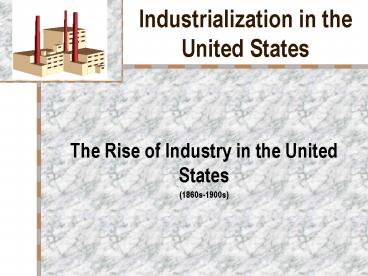Industrialization in the United States - PowerPoint PPT Presentation
1 / 29
Title:
Industrialization in the United States
Description:
Industrialization in the United States The Rise of Industry in the United States (1860s-1900s) * * Oil town/field * Oil field * Iron ore mine – PowerPoint PPT presentation
Number of Views:259
Avg rating:3.0/5.0
Title: Industrialization in the United States
1
Industrialization in the United States
- The Rise of Industry in the United States
- (1860s-1900s)
2
The Rise of Industry
- After the Civil War (1865) the U.S. economy was
based on agriculture - By 1920, the U.S. was the leading industrial
power in the world! - Enormous growth was due to 3 factors
- Natural Resources
- New Inventions, Technology
- Support from the GOVT
3
An Abundance of Natural Resources
- MAIN IDEA Natural resources and a large labor
force allowed the United States to industrialize
rapidly.
4
What natural resources were abundant in the
United States?
5
(No Transcript)
6
(No Transcript)
7
(No Transcript)
8
(No Transcript)
9
(No Transcript)
10
(No Transcript)
11
(No Transcript)
12
(No Transcript)
13
Why is it important that these resources were IN
the United Sates?
14
Drake Discovers BLACK GOLD
- 1859, Edwin Drake used a steam engine to drill
for crude oil (petroleum) - This breakthrough started an oil boom in the
Midwest and later Southwest - At first the process was limited to transforming
the oil into kerosene and throwing out the
gasoline a by-product of the process
15
(No Transcript)
16
Iron just wasnt cutting it
- Henry Bessemer started playing around with
military technology - Developed the Bessemer Process!
17
BESSEMER STEEL PROCESS
- When you remove the carbon from iron, the result
is a lighter, more flexible and rust resistant
compound Steel! - Bessemer process
18
Importance of Bessemer
- Decreased cost
- Increased speed and ease of production
- Mass production
- Expanded the market for Steel
- Allowed for larger and more powerful machines
19
NEW USES FOR STEEL
- The railroads, with thousands of miles of track,
were the biggest customers for steel - Barbed wire, farm equipment, bridge construction,
and the first skyscrapers.
Brooklyn Bridge, 1888 1,595 ft.
20
New Inventions and the Development of Technology
- MAIN IDEA New inventions spurred economic and
industrial development.
21
(No Transcript)
22
Edison, Westinghouse and ELECTRICITY
vs.
23
(No Transcript)
24
THE TYPEWRITER
- Christopher Sholes invented the typewriter in
1867 - His invention forever affected office work and
paperwork - WHO did it effect the most?
- 1870 _________ 5 of workforce
- 1910 ______40 of workforce
25
THE TELEPHONE
- 1876, Alexander Graham Bell and Thomas Watson
unveiled the telephone - 1877, Bell Telephone Company American Telephone
Telegraph Company (ATT)
26
- Free Enterprise Allowed for Massive Economic
Growth
- MAIN IDEA Laissez-faire economics promoted
industrialization and tariffs protected American
companies from foreign competition.
27
Laissez-faire Economics
- Following the Civil War, the government took a
hands-off approach (for the most part) to
business throughout the country. - Laissez-faire
- There were barely any Economic regulations AND
Social regulations (for the most part) on
corporations throughout the country. - Left to state governments
28
Post-Civil War Economics
29
Laissez-faire Economics and Protectionism
- On top of a Laissez-faire approach to the
economy, the Republican dominated Federal
Government practiced protectionism - Morrill Tariff, 1861
- Are tariffs good or bad? Why? Explain.
- North v. South
- Republican v. Democrat































